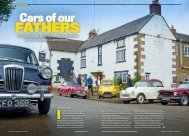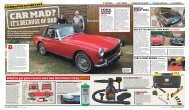Create successful ePaper yourself
Turn your PDF publications into a flip-book with our unique Google optimized e-Paper software.
GORDON HODGSON - PART ONE<br />
For almost 40 years, since the 1978 revival<br />
of main line steam in the North West,<br />
Carlisle engineman Gordon Hodgson has<br />
been one of the stand-out names in the<br />
‘top link’ of men who drive and fire our<br />
steam charter trains, week in, week out.<br />
A proud and articulate professional who began his apprenticeship<br />
as a fireman on the Waverley Route as long ago as 1957, Gordon’s<br />
‘oneness’ with a locomotive and his predilection for ‘driving to<br />
the full’ has been a trademark long acknowledged by footplate<br />
colleagues, and one certainly appreciated by enthusiasts.<br />
At just 5ft 6in in his stockinged feet, there have long been jokes and<br />
banter among footplate colleagues about him needing a stepladder<br />
to get the regulator handle down from the roof, but Gordon’s record<br />
speaks for itself: holder of the ‘Blue Riband’ for the fastest run to Ais Gill<br />
summit with a Class 7 engine, fastest recorded time between Carlisle<br />
and Shap summit with 12 coaches, the highest sustained power output<br />
(2,900bhp) up Beattock (all, coincidentally, with the ‘A2’ class ‘Pacific’<br />
No. 60532 Blue Peter) and many more besides.<br />
Locomotive fitness and efficiency may be variables, but the name<br />
Gordon Hodgson on ‘A4’<br />
Union of South Africa at<br />
Hellifield on March 30 2013.<br />
EDDIE BOBROWSKI<br />
I came back home from the<br />
medical, and I’m not ashamed to<br />
admit it, I had a good old cry<br />
‘G. Hodgson’ on a steam crewing notice has been the nearest you<br />
could get to a guarantee of exhilarating, polished performance.<br />
As he says: “There’s a fine margin between using and abusing an<br />
engine, but for me, express locomotives should always be driven at<br />
full regulator, to get the maximum benefit out of superheat.”<br />
In July last year though, Gordon’s name suddenly disappeared<br />
from West Coast Railways’ crewing roster. There were no reports<br />
to say he had been ill - and retirement for a man so passionate<br />
about steam and so staunchly wedded to the footplate was quite<br />
unthinkable. He was simply there one minute, and gone the next.<br />
Some days later, the grapevine brought the news that Gordon,<br />
then 77, had failed his six-monthly medical - on his hearing. His<br />
footplate career - just six months short of 60 years - was suddenly<br />
at an end. That he was still as fit as a flea, demonstrated the mental<br />
agility of men half his age, and walked England’s<br />
highest fells on his days off, counted for nothing.<br />
Devastated<br />
Friends and followers met the news of Gordon’s<br />
enforced retirement with sadness and sympathy,<br />
but to the man himself, it was a devastating, lifechanging<br />
thunderbolt. It felt as though the bottom<br />
had fallen out of his entire world.<br />
“I came back home from the medical, and I’m<br />
not ashamed to admit it, I had a good old cry,” he<br />
admitted when I met him at his Carlisle home a<br />
few weeks ago. “It wasn’t how I’d expected to retire<br />
from the railway. I was so hoping to get that 60<br />
years in, at least.<br />
“I always knew that the hearing in my right ear wasn’t as good as<br />
in my left, but I never had any fears or qualms about the medical.<br />
The doctors used to say to me that considering the environment<br />
I’d been working in - on a noisy footplate over so many years - my<br />
hearing was generally better than might be expected.<br />
“The practical test involved hearing someone speaking at a<br />
certain distance away, and checking that I could use radios and<br />
telephones without any difficulty. I’ve got a hearing aid, and that’s<br />
fine when I’m working a diesel - but it was useless on a steam<br />
engine because there’s so much ‘percussion’ and echo in the<br />
receiver that it’s difficult to differentiate one noise from another.<br />
Everything was being drowned out.<br />
“I asked the doctor if I could take the test again - but he said<br />
no. He was sorry, but he had to draw the line somewhere. I was<br />
devastated. I’d expected to pass the practical test again - but as the<br />
doctor said, if anything happened as a result of my hearing - any<br />
incident - it would come back on him, and he would be out of a job.<br />
“During previous medicals, some of the doctors had asked me<br />
how long I intended to continue on the footplate. I always said that<br />
I’d carry on for as long as I still felt capable, confident and happy<br />
doing it - but the moment I felt uncomfortable doing it, I’d stop.<br />
I never reached that stage.<br />
“One of the biggest disappointments was losing the last year on<br />
the Settle line, following the major landslip in the Eden Gorge near<br />
Armathwaite, in February last year. Sixty or seventy per cent of my<br />
work was on the Settle & Carlisle.<br />
It hardly looks like a shed about to close, but this was Carlisle Canal, taken<br />
from the coaling stage on the last weekend before the locomotives were moved<br />
to Kingmoor on June 10 1963. The fulsome variety of engines in steam includes<br />
‘A4’ No. 60012 Commonwealth of Australia, ‘A3’ No. 60100 Spearmint, ‘V2’<br />
No. 60816, ‘B1’ No. 61099 and, just visible out of steam on the far road of the<br />
straight shed, ‘Britannia’ No. 70020 Mercury. Also identifiable in the frame are<br />
‘Black Five’ No. 45195 and Fairburn 2-6-4T No. 42187. Peter J. Robinson<br />
Issue 467 • MAY 19 - JUNE 15 2017 • 85

















